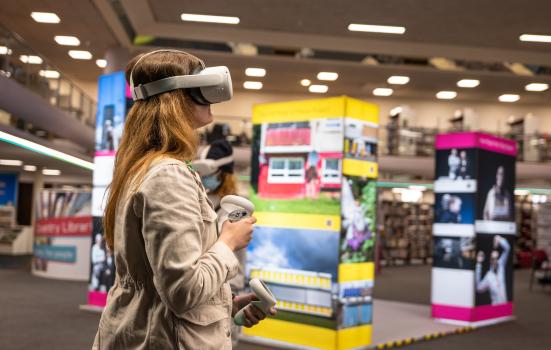If we can find a shared language and inclusive approach to evaluating digital arts and culture, we can tell a better story about the difference it’s making, write Rosanna Chianta and John White.

Hayley Salter
Digital innovation is thriving in the sector. You don’t have to look far to find examples of artists and organisations exploring new ways to engage audiences online or using emerging technologies to promote creativity in different settings.
In recent months, the V&A launched mused, a website for 10-14 year olds which uses a trend-spotter panel and SEO analysis to inform relevant content for its target audience. Birmingham Royal Ballet launched its Virtual Stage, which, along with DaDa’s Holograms project, demonstrates how the sector is investing in improving accessibility. And artists continue both to interrogate and to harness social media culture to create thought-provoking work. Louise Orwin’s FAMEHUNGRY, which uses TikTok Live to investigate the attention economy, is an example of this.
Despite this innovation, we know overall there has been a shift away from digital programming towards in-person experiences, as organisations focus on rebuilding audience attendance to 2019 levels. As Ash Mann has noted, “research such as the AHRC-funded Digital Access to Arts and Culture Beyond Covid-19 project has shown the snap back to the pre-Covid (mostly non-digital) status quo has been rapid, and pronounced”.
Making digital work inclusive and accessible
At The Space, we believe one of the contributing factors to this shift is the challenge of understanding, measuring and communicating the impact and the value of digital work.
Since our launch in 2014, The Space has commissioned and supported the production of over 400 digital arts and cultural projects. From delivering local history soundscapes to people living with dementia, to working with public libraries to broaden their audiences through immersive VR experiences and community co-creation, we’re passionate about making digital work as inclusive and accessible as possible. We want to ensure people from all backgrounds, with diverse lived experiences, can engage with moving, relevant artwork.
We always work with the people we commission to evaluate audience engagement and other outcomes from projects. In doing so, we've realised evaluation often focuses on reach and misses the full range of value projects might be generating. Does counting three second views on Facebook really tell you much about meaningful engagement? How might we measure the impact an online experience has on well-being, or the skills development that working on a digital project provides?
Lack of defining criteria
Earlier this year, we commissioned the University of Exeter to research existing frameworks for measuring the impact of cultural activities in general, and digital content in particular. They interviewed funders, cultural organisations and digital content specialists about the opportunities and challenges of undertaking effective evaluation.
Their research found the barriers organisations face when assessing the impact of digital cultural content are rooted in limited availability of and access to resources – namely time, expertise and funding. What stood out the most, however, were challenges around definition and meaning, pointing to a lack of defining criteria for measuring impact. The researchers also found limited collaboration between organisations, which may explain the lack of uniformity in data and methods of assessment.
We want to undertake further work to develop a shared language and inclusive approach to evaluating digital cultural experiences. We hope, as a sector, we can become more confident in talking about its impact. This would also help funders and other stakeholders to more precisely assess the value that investing in these experiences generates for cultural organisations, creative practitioners and their audiences.
The Centre for Cultural Value’s Evaluation Principles provide a useful starting point. In 2021, the Centre responded to growing, industry-wide demand for support with evaluation. The result was the Evaluation Principles – a collection of critical ideas that guide cultural sector workers through the process of evaluation. They have also published a Wheel of Change evaluation framework that can be tailored to the scale and scope of your work.
Providing a useful testbed
We’re exploring how these tools might inform a sector-wide approach to evaluating digital projects, so we can tell a better story about the difference digital arts and culture is making. For this approach to be effective, it must be accessible to teams with different levels of resource, and flexible enough to be tailored to projects with different objectives.
We hope the work The Space commissions can provide a useful testbed and we want to collaborate with others to ensure we consider the full range of content and ways to embed good practice and common terminology.
What dimensions of value might we measure for digital cultural experiences? For participants, the potential value might be entertainment, education or an increased sense of well-being. For producers and publishers, it could be audience development, brand building, financial value or skills development. And for wider society there might be environmental or other benefits. An effective project evaluation would be selective about which dimensions it focuses on, depending on its objectives.
So, what's next? We’re in the early stages of planning and looking for collaborators. If you have examples of digital evaluation you’d like to draw to our attention, a digital project you might like to test out with a new evaluation approach, or if there are other ways you like to work with us, we’d love to hear from you. Please email us at contactus@thespace.org.
Rosanna Chianta is Head of Content Distribution & Audience Metrics at The Space.
John White is Chief Operating Officer at The Space.
![]() thespace.org
thespace.org
![]() @thespacearts
@thespacearts
This article, sponsored and contributed by The Space, is part of a series spotlighting new ways of creating and distributing digital content, and exploring the wealth of new technologies and platforms coming online.






